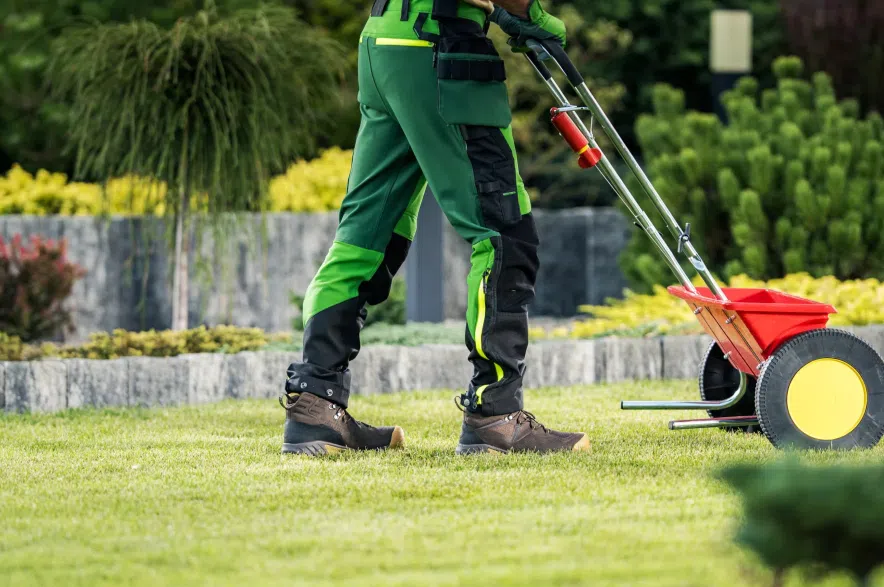Jill and Rick Van Duyvendyk answer all your gardening questions in Garden Talk on 650 CKOM and 980 CJME every Sunday morning at 9 a.m. Here are some questions and answers from the June 22 show:
Read more:
- Garden Talk: Solutions for all your lily problems
- Garden Talk: Save money by being water wise in your yard this summer
- Garden Talk: Can fruit be affected by wildfire smoke?
- Garden Talk: What are those white fuzzy spots on my plant?
These questions and answers have been edited and condensed for clarity.
Q: When I fertilize my lawn, what setting should I use on my spreader so I don’t burn it?
A: If you’re using a 30-plus nitrogen fertilizer, you have to be very careful. Ground Keeper fertilizer has 16 nitrogen, but the reason why it does so well in Saskatchewan, especially in central areas, is because of the sulfur and iron in it.
If you are using slow-release fertilizer, unless you stop and dump a whole bunch in one spot, you’re not going to burn it that easily. Most fertilizer bags say what setting to use but Ground Keeper gives you a rate. With mine was left it exactly where it was from when I used to buy Scott’s fertilizer, I think it’s seven and a half is the number.
If you want really good coverage with a spreader don’t set it at a higher setting, set it a little bit lower and go one way then in a grid the pattern in the opposite direction. A grid pattern means you will get a more consistent, greener lawn.
A general rule is to set the spreader below half setting and around one third. Do a quick spread in your driveway and to check it is a consistent covering, it doesn’t
have to be white.
See Dutch Growers’ Complete Lawn Care Guide here.
Q: What can I do about the abundance of ants and ant holes the lawn and my garden?
A: Keep your lawn thick. Overseed it and fertilize it. Ants don’t like nice, lush, thick lawns, they like sparse and dry lawns.
If you don’t want to fertilize and water your lawn because you don’t like cutting your grass, you will get more dandelions and insects, so you have a choice to make — do you want bugs or do you want grass?
You can use nematodes, but you still have to water. Right now would be a perfect time to apply because of the rain. You have it make it moist down to where the nest is, which is eight to 12 inches down. Nematodes will basically decimate those ant colonies.
Q: What can I do to fix thinning sod with some dead spots?
A: What’s underneath the sod is usually the issue. A lot of places don’t have six inches of topsoil underneath the sod, which is what is needed. You can cut your grass low and then top dress with a thin layer of soil each year to build it up. You can also overseed.
Also use the right fertilizer. Do a pH test, find out if your pH of your soil is really high. If it is, you need to use a sulfur based fertilizer. If the sod is very light colored green, it’s not taking up nutrients.
Q: What are the tiny bugs on a lot of my plants?
A: Most likely aphids. They come in a variety of colours including red, black, and lime green. They adapt as they need to. When they’re first born, they don’t have wings and then the second batch, because they might eat the host plant, need to go to another place where there’s food, so they develop wings.
A bird bath or a water feature that attracts birds will help keep it under control. There will be always be some bugs, though. You can buy or attract some ladybugs. Dutch Growers has the first shipment of ladybugs arriving this week. We haven’t been able to get them because of all the wildfires.
Q: What plants can I use to cover a decorative sloped rock wall?
A: Low growing juniper will grow between the rocks because they get established they don’t need a lot of water. Creeping sedums, thyme, and creeping Jenny (moneywort) comes in green or gold and does well in sun or shade but needs a moist environment. If it is a shady location try mosses and some clovers would look good.
Q: How should I care for wild dwarf irises?
A: Wild irises grows more in boggy areas in ditches. They like soil that’s a little bit more moist. They like to be in part sun and part shade and don’t like a lot of nitrogen so don’t use a high nitrogen fertilizer and then otherwise you’ll just get leaves and no flowers. Split and divide them about every three to four years but don’t take more than about a third off the plant at a time.
Q: Should I pinch off where the flowers on the lilacs grew this year to encourage more flower growth for next year?
A: Yes, but do it now. Prune and then fertilize them to get the growth happening. Every time you pinch one place, you get two stems coming out and that’s where your blooms will be next year.
Q: What varieties of yellow and pink potentilla are suitable for Saskatoon?
A: Yellow ones include Dakota Sunspot and Gold Star is another one. If you want a low one, try Yellow Gem. For pink there’s Pink Beauty. There’s Bella Bellissima and Happy Face.
Potentillas are making a comeback and they’re starting to come in more colours. Marmalade starts yellow and turns apricot, almost like a sunset.
Q: How much can force your tomato plants to grow with fertilizer?
A: You will definitely see if you don’t fertilize, you’re going to have a stunted plant and not much fruit. If you use too much nitrogen, then you’re not going to gain anything, you’re actually making things worse. You need to find a balance.
Once the fruit has set hold back on your fertilizer because if you keep fertilizing them, they’ll develop too quickly and then you’ll go the other way as well.
Consistent watering will help and use organic fertilizer like alfalfa pellet tea. It’s not a ton of nitrogen, but it’s enough to keep them going, and has all those micronutrients that make the plant healthy and produce like crazy.
Heat is the biggest thing. Put a mini greenhouse over top of your plant or a cozy coat, which is basically a plastic coat where you fill the columns up with water and so the sun heats them and warms the plant up. Also keep them out of the wind.
Q: What can I do when my multiplying onions won’t multiply?
A: They need proper chilling, so they might not have been chilled properly. Overcrowding them can often be a problem, or too much nitrogen in the soil. They need lots of sun as well.
You might have to add some organic material into the soil but don’t overdo it because ground crops don’t like a ton of it. Top dress with a bone meal or a well balanced even a 10-10-10 or 14-14-14 fertilizer would be a good idea, too.
Q: My mock orange shrub looks dead in the inside. Should I cut it down significantly?
A: Don’t do it right now because they are blooming. Cut it down down to about two feet off the ground in the fall after the leaves drop. It’ll take a couple of years before it’ll gets big again, but fertilize it every three weeks with 30-10-10 and you’ll get lots of growth and lots of flowers.
Q: My peonies have not bloomed in four years since they were transplanted. What
can you suggest to help them bloom?
A: It takes a couple of years after you transplant to get them to flower, especially if you cut them into small eyes, but they should be blooming by now. Use an organic fertilizer. They might have been planted too deep because that will cause them not to bloom. The eyes need to be just maybe an inch or two at the most under the soil, so you might want to dig them up and replant a little bit shallower, but wait until it’s dormant.
Q: Is alfalfa fertilizer suitable for lilacs and Japanese barberry?
A: If you want tons of growth, you’ll need one with higher nitrogen. Otherwise, it’s good for any plants.
Read more:











